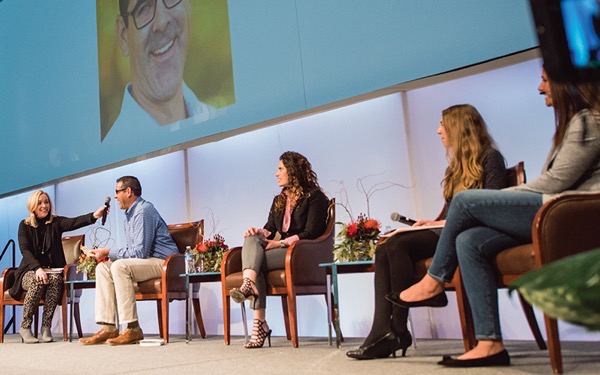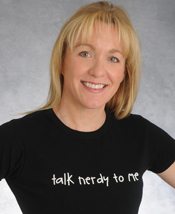Machine Learning and the Pursuit of Happiness
By Leslie Ellis
In early November, I had the good fortune to host a session at the 2018 Tech It Out, hosted by Rocky Mountain WICT, at the freakishly tech-centric Infinity Park Event Center in Glendale, CO — picture a rectangular room, just wrapped in pixels.
The session, titled “Show & Tech,” is a “back by popular demand” part of the program (now in its 12th year), but this was the first time it was “on me” to find the best tech nuggets — the best nerdy little secrets! — to bring into the foreground.
Happily, it all sort of… came together. And as it came together, a theme emerged: Happiness. Specifically, happiness indices, informed by machine-level telemetry data and artificial intelligence: A customer happiness index, a honeybee happiness index, a Wi-Fi happiness index.
As well, a small, modest sidecar to a pair of eyeglasses that narrates what it sees — the color of a shirt, a $10 bill vs. a $100 bill, a bottle of beer vs. a bottle of olive oil. In the demo, my co-host, Josh Seiden, VP for Comcast Innovation Labs and someone who professionally mentors two technology accelerators — Boomtown, in Boulder, and The Farm, in Atlanta — donned the glasses and looked at me, at which time the small speaker on the gadget identified me by name. (The glasses had to “learn” me ahead of time. It took about a minute, during which I discussed a recent road trip to Arizona, and moved my head hither and yon; it was easy, in other words.)
And, from Comcast software engineer Daisy Henderson, a “Safe Sound” mechanism that automatically dampens loud sounds, like explosions, in a TV show or movie. The intent: To make it more enjoyable for people with PTSD, Alzheimer’s, and autism to watch TV, without being startled or otherwise triggered.
Customer Happiness Index:
Wicket Labs’ Kat Schelonka demonstrated how machine data related to how people who watch online video content can predict and dissuade churn. The higher the “CHI” (pronounced “chee”), the more likely you’re a happy customer.
Honeybee Happiness Index:
I kind of embellished this one. As in, the manufacturer doesn’t use the term “Honeybee Happiness Index,” but, the intent is the same. Technically, the OSBeehive pairs a sensor device with a companion app that tracks sound and vibration in a beehive. That data is used to determine one of six outcomes: Healthy, Dormant, Missing Queen, Swarming, Collapsing, and Collapsed.
(As a beekeeper, I can attest that the one way to know for sure that a honeybee colony is unhappy is when its queen is sick or missing. And the one thing that’d be super helpful to know about a colony is when it’s about to swarm — because each “captured swarm” is essentially worth about $300, were you to have to buy bees.)
Wi-Fi Happiness Index:
By now it’s clear that people value their Wi-Fi connection more than just about anything, including clean clothes. That’s why the folks over at RDK, and Comcast, are developing a way to make a subjective assessment (is the Wi-Fi working well?) from objective, machine-level data coming out of residential gateways. Patti Loyack, VP of IP Services for Comcast, demonstrated that and related developments designed to provide overall peace of mind. (Including a web cam that spotted both a teenage party, when the parents were away, and a Colorado black bear.)
That’s a quick look at how machine learning and artificial intelligence — ML and AI, in the lingo — are emerging as ways to make life better, whether you’re a honeybee or a human.

The author, left, with Josh Seiden, Comcast, Daisy Henderson, Comcast, Kat Schelonka, Wicket Labs and Patti Loyack, Comcast, during the “Show & Tech” portion of the 2018 Tech It Out program, hosted by Rocky Mountain WICT.
 Leslie Ellis,
Leslie Ellis,
President,
Ellis Edits Inc.
leslie@ellisedits.com
Leslie Ellis is a tech writer focused on explaining complex engineering stuff for people who have less of a natural interest than engineers. She’s perhaps best known (until now!) for her long-running weekly column in Multichannel News called “Translation Please.” She’s also written two broadband dictionaries, one field guide to broadband, and is co-author of “Planet Broadband” with Roger Brown and Stewart Schley. She’s served as Senior Technology Advisor to CTAM since 2001, and is a behind-the-scenes tech translator for domestic and global service providers, networks, and suppliers.
Shutterstock
Tommy Cowan / T5 Photography




